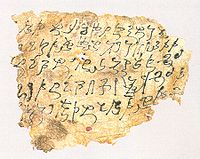- Kharoshti
-
Alphabet kharoṣṭhī
Kharoṣṭhī Caractéristiques Type Alphasyllabaire Langue(s) Pâli, sanskrit, prâkrit Direction Droite à gauche Historique Époque IVe siècle av. J.-C. - IIIe siècle Système(s)
parent(s)Protosinaïtique
Phénicien
Araméen
KharoṣṭhīEncodage Unicode U+10A00 à U+10A5F ISO 15924 Khar L'alphabet kharoṣṭhī aussi connu sous le nom d'alphabet gāndhārī est un ancien alphasyllabaire utilisé pour noter le gandhari et le sanskrit par les scribes du gandhāra. Il fut utilisé du milieu du IIIe siècle av. J.-C. au IIIe siècle. On l'utilisait aussi le long de la route de la soie où il aurait survécu jusqu'au VIIe siècle dans les relais isolés de Khotan et de Niya.
Les spécialistes ne sont pas d'accord sur l'origine du kharoṣṭhī, soit qu'il ait évolué au fur et à mesure, soit qu'il soit l'invention d'un scribe de génie. L'analyse de l'alphabet montre une relation nette avec l'alphabet araméen, auquel on a ajouté des symboles supplémentaires pour noter les phonèmes des langues indiennes. Une hypothèse propose que l'alphabet araméen arriva avec la conquête des Achéménides en 500 avant J.C. et évolua pendant 200 ans pour atteindre sa forme finale vers le IIIe siècle av. J.-C.. On n'a cependant pas retrouvé de formes intermédiaires qui confirmeraient cette hypothèse.L'étude du kharoṣṭhī a été revigorée récemment par la découverte de textes bouddhistes du gandhâra écrites en kharoṣṭhī, retrouvés près de la ville de Hadda en Afghanistan et confiés à la British Library en 1994. Les manuscrits sont datés du Ier siècle, ce qui en fait les manuscrits bouddhistes les plus anciens qui existent.
Le kharoṣṭhī occupe en Unicode la plage U+10A00—U+10A5F depuis la version 4.1.0.
Sommaire
Voir aussi
Articles connexes
Références
- (en) Kenneth R. Norman's, The Development of Writing in India and its Effect upon the Pâli Canon, in Wiener Zeitschrift für die Kunde Südasiens (36), 1993
- (de) Oscar von Hinüber, Der Beginn der Schrift und frühe Schriftlichkeit in Indien, Franz Steiner Verlag, 1990
- (de) Harry Falk, Schrift im alten Indien: Ein Forschungsbericht mit Anmerkungen, Gunter Narr Verlag, 1993
- (fr) Gérard Fussman, Les premiers systèmes d'écriture en Inde, Annuaire du Collège de France 1988-1989
Liens externes
- (en) Informations sur l'alphabet Kharoṣṭhī
- (en) [pdf] Étude préliminaire de la paléographie des manuscrits Kharoṣṭhī par Andrew Glass, Université de Washington (2000)
- (en) L'Origine des premières écritures de l'Inde par Richard Salomon, Université de Washington
- (en) [pdf] Demande d'inclusion de l'alphabet Kharoṣṭhī dans Unicode
Catégorie : Alphasyllabaire
Wikimedia Foundation. 2010.

